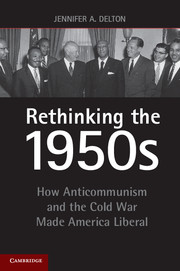Introduction: The Liberal Fifties
Published online by Cambridge University Press: 05 October 2013
Summary
Most historians see the 1950s as a conservative era in U.S. history, a time when anticommunism subverted reform, crushed dissent, and ended liberal dreams of social democracy. According to historians, the Cold War, McCarthyism, and the Eisenhower administration represented a turn to the Right, a negation of New Deal liberalism, an end to reform. The warfare state canceled out the welfare state. True, there were the beginnings of a civil rights movement, a Beat culture, and other signs of discontent and change, but these occurred on the margins of society. The political economy and the dominant political discourse were, historians tell us, conservative.
Yet throughout the 1950s, the U.S. government redistributed wealth, taxed the rich, regulated corporate practices, engaged in public works projects, and generally carried out a liberal, New Deal agenda. This book argues that, far from subverting the New Deal state, anticommunism and the Cold War enabled and fulfilled the New Deal’s reform agenda. It shows that anticommunism solidified liberal political power in the late 1940s and that the Cold War furthered liberal goals such as jobs creation, corporate regulation, economic redevelopment, and civil rights. It shows that, despite President Eisenhower’s professed conservatism, his administration maintained the highest tax rates in U.S. history, expanded government programs, and supported major civil rights reforms. It shows that conservatives were on the defensive in the 1950s and that the Cold War divided and weakened the conservative movement. Its evidence comes from existing primary and secondary sources.
- Type
- Chapter
- Information
- Rethinking the 1950sHow Anticommunism and the Cold War Made America Liberal, pp. 1 - 12Publisher: Cambridge University PressPrint publication year: 2013



